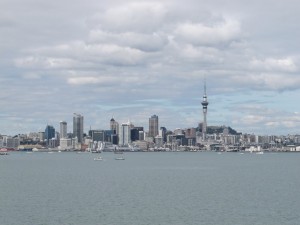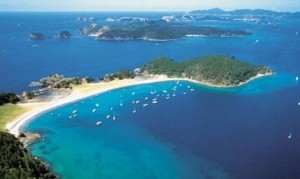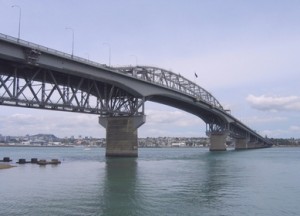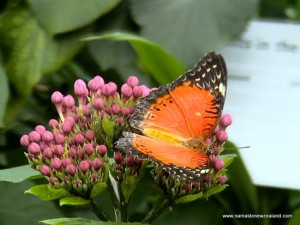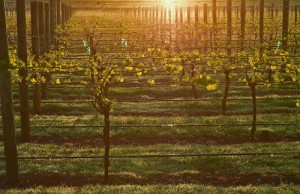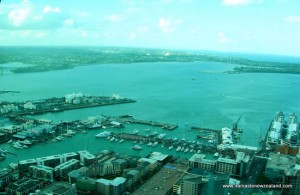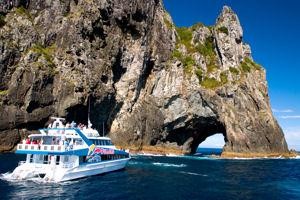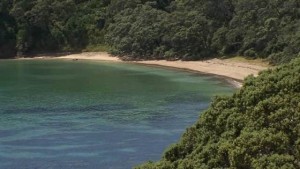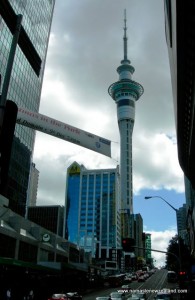
Self Drive and plenty at Bay of Plenty
Self Drive is undoubtedly the best way to See New Zealand and I personally experienced the advantages of Self Driving in New Zealand as we started the next leg of our itinerary. We picked up 4 x 4 vehicles from Budget Rent-a-Car from Auckland airport.
Before you plan to Self Drive in New Zealand, let us look at what are the advantages for the Indian traveller. Firstly, driving in New Zealand is on the same side of the road like India. Secondly, your Indian driving license is valid and you do not need to apply separately for an international driving license. However, it is important that your date of birth and name in the driving license is the same as on your passport as at times there may be discrepancy and in such cases your license will not be accepted by car rental companies. Thirdly, you should have an international credit card which is swiped by the car rental company at the time of handing over the keys to you to recover any liabilities that may be due such as fines for speeding, etc.
Personally, I have driven in Switzerland as well as from Montreal to New York and I did find that for a first timer who has not driven outside India, New Zealand is the best place in the world to Self Drive as firstly the roads are not very busy, secondly it is easy to navigate across the country and the only thing you need to adhere to are the basic principles of following the traffic regulations and guidelines and you can definitely explore more of New Zealand self driving rather than taking a seat-in-coach tour.
There are various car rental companies who offer one way rentals. So you could start your self drive from Auckland and cover major regions of North Island and ferry your car across Cook Strait from Wellington to Picton and then explore South Island. You should be equipped with a good map book and have a navigator sitting next to you who can assist you in taking the right route to your destination.
One of the better map books worth investing is the New Zealand Travellers Road Atlas by kiwipathfinder and you can get it at any bookshop in New Zealand for less than 30 New Zealand dollars (under Rs 1000). It is worth the investment whether or not you are self driving as it gives you a detailed maps of the entire country including town maps, North and South Island touring routes and much more. So even if you are taking a seat-in-coach tour, you can keep track of your route with distances by referring to your map book.
After picking up our vehicles from Budget Rent a Car, we first chalked out the route to head towards Tauranga which is also known as Bay of Plenty, a name given by the 18th Century Navigator James Cook as the Bay is a haven for nature lovers, adventure seekers and is set in a natural harbour surrounded by vast, clean, ocean and beaches.
The region is one of the country’s premier holiday destinations and is located 2 hours 30 minutes away from Auckland. We started from Auckland airport and headed south towards the direction of Hamilton. As we reached Bombay Hills, we turned in the direction of State Highway 2 which would take us to Tauranga. Whilst driving on highways the maximum speed limit is 100 kilometres per hour whereas in the city and urban areas the limit to be maintained is 50 kilometres per hour.
We checked in at the Oceanside Twin Towers Resort which is a luxury five star accommodation located at the foot of the Mount and offers stunning ocean and harbour views from private balconies which face the coast.
The resort has a wide range of accommodation starting from one and two bedroom suites which are fully equipped with kitchens complete with fridge freezer, oven, microwave and complimentary tea and coffee. The two bedroom apartments can accommodate upto six people and is ideal for larger families. Then they also have the honeymoon suite as well as executive studios and large luxury apartments.
We were to spend two nights at Mount Maunganui and the Bay of Plenty as the region has plenty to offer. So after a quick check-in we were joined by a local Maori guide Mere who took us for a cultural walk up the Mount. During this 40 odd minute trek up the mount, she narrated to us how the Maoris came here. It was drizzling and the walk was one of the most exciting experiences of our trips as not only did we get breathtaking views of the Tauranga Moana Area but also got an insight into the history of the Maori people.
Later that evening we had the opportunity to explore the area. Across the Main Beach there are a number of cafes and the downtown areas offers a wide array of restaurants besides opportunity to shop in one of the boutique shops as well. The region is very popular for surfers, swimmers and those who want to try out some of the water sports activities and hence one can find many youngsters and sports enthusiasts frequenting this area.
Later that evening we dined at the award winning Latitude 37 restaurant which offers international cuisine. I would highly recommend any visitor to this region to visit the restaurant located at 37 Maunganui Road not only known for its culinary innovation but also for the ambience. It is one of the newest restaurants in the area.
The following morning after breakfast, we headed to Whakatane which is 90 kilometres from Tauranga and in about 1 hour 30 minutes we reached this coastal town which is the main base for trips to White Island – New Zealand’s only live marine Volcano which lies around 50 kilometres off the coast of Whakatane. White Island can be accessed either by boat or by helicopter.
We did not know whether it was possible to step aboard the Peejay and head towards White Island and this would be our first experience to walk on an active volcano. I was pretty excited and before boarding the Peejay we had to check-in at the White Island rendezvous located on the Whakatane wharf where the crew gave us a briefing before we boarded the vessel.
Our boarding the vessel and alighting on White Island was subject to weather conditions and therefore it is always a good option to have a back up plan in case the tide is high and it gets difficult to get to White Island.
There are several places that one could visit such as Te Puke or the Kiwifruit Capital of the World which is located very close to Whakatane and is 25 kilometres away from Tauranga. Kiwi360 offers the largest visitor attraction in the Western Bay of Plenty and is the international home of Kiwifruit. You can climb aboard a Kiwicart and tour the orchards as well as visit the Horticultural Theme Park and discover why Kiwifruit is the world’s healthiest fruit. It grows better in New Zealand than anywhere else in the world.
Although it was drizzling a day earlier and there was cloudy weather as we left Mount Maunganui, there was good news as we were told that the Peejay boat would be heading to White Island. The entire duration including going and returning from the island by boat is 5 to 6 hours. The trip from the wharf is 80 minutes. If you get fine weather you could enjoy a smooth sailing along with view of active marine life. We happened to see a few seals on the way perched on a rock. We were first given a briefing about the do’s and don’ts of the trip and were handed some safety gear which consists of a hard hat. However, we were unlucky as within a few metres of proximity of White Island the sea started getting rough and we were forced to turn back. So we missed out on what would have been an exciting trip.
However, the crew on board knowing our disappointment did tell us what the tour generally comprises of. Once you are close to White Island, you are ferried across on an inflatable boat to a concrete jetty and after climbing a short ladder and negotiating a few boulders, you reach the shore where the tour of the active marine volcano begins. You walk along the inner crater and see the remains of old sulphur mining factory up and close and view the bright yellow sulphur crystals as you reach the main crater’s edge. Here you can here the hissing, roaring and feel the steam rising from the crater lake and feel the awesome power of Mother nature. After this experience, you board your boat and have lunch before heading back to the shore.
In our case we headed back within the first 80 minutes due to bad weather but that gave us the opportunity to visit the Comvita Visitor Centre which is located close to the Paengaroa village at a short distance after the intersection of State Highways 2 and 33 as you head from the Whakatane Wharf back to Mount Maunganui. It is located on the road which leads to Rotorua.
At Comvita we had the opportunity to visit the education gallery to experience live bee displays and sample the native Manuka honey of New Zealand. After a short halt at Comvita, we proceeded towards Longridge Fun park which was a few kilometers away. We were greeted warmly by Geoff and Mary Brown – the owners and operators of this wonderful child friendly place which gives you a truly KIWI experience. After a quick lunch, we spent the next couple of hours on this 125 acres property which has loads of activity for children of all ages and is a place to spend an entire day.
You can do a farm tour and feed farm animals or take a jet boat on the Kaituna river and get the thrill of 360 degree jet spins besides enjoying a 30 minute ride through a narrow, native, bush-clad gorge thru one of North Island’s most scenic river. You can walk in the orchards and pick your kiwifruit or even go on a 4W U-Drive on an adventurous track or even do white water river rafting. No doubt it is extremely popular for kids as we did see a school bus full of kids who were out enjoying themselves on a day excursion at Longridge Fun Park. Later in the day, we visited Blokart Heaven which is in close proximity at Papamoa on the way when you head back to Mount Maunganui. A blokart is a small, highly maneuverable wind-power kart and is a combination of go-kart and a wind surf sail weighing about 29 kilograms and this is the only place in the world where you can experience the thrill of this adventure sport on a purpose-built blokart speedway and maneuver your vehicle keeping in mind the direction of the wind. It’s an ideal place to test your skill and it is the ultimate place to test your skill on this land yacht.
This invention over the years has gained enough popularity that there are international blokarting tournaments and this invention of Paul Beckett has today become the world’s number one land based sail sport. Because of its small size and maneuverability, once you learn the skill to use it blokart can be used anywhere – on beaches, in sports and recreation areas and even on ice. It is portable as the 29 kg blokart can easily fit in the trunk of a car. It takes a few minutes to either assemble or pack it that too without the use of any tools. There are several blokart clubs across the world. Blokart is one more invention from New Zealand – the most innovative country for adventure sports. After a long day and loads of activity that we experienced we headed back to Mount Maunganui and later we dined at Bombay Brasserie- an Indian restaurant in the downtown area of the Mount. Indian food is indeed popular in New Zealand and you find Indian restaurants almost everywhere and not just in the big cities.
Bay of Plenty has plenty to offer and we had the opportunity to try out some of the activities that the region is well known for. The next morning we headed to the birth place of tourism almost a 100 years ago – ROTORUA the land of geysers, spas, adventure and Maori culture and what better way to start our tour of this city than to jump from an altitude of 12000 feet and free fall at the speed of 200 kmph?



